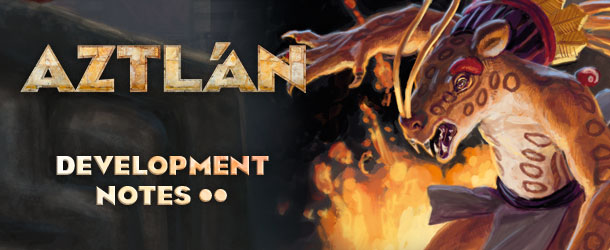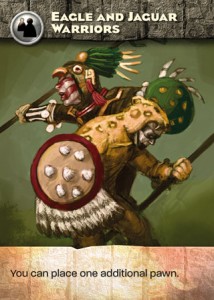Roberto Di Meglio, director of production of Ares Games, speaks about Aztlán, the new game by Leo Colovini that will be released at the Essen “Spiel 2012”. This second article is focused on how the game works.
Aztlán may be considered a very peculiar “hybrid” between a wargame and an Euro game. It shares the design philosophy of the previous games by Leo Colovini: simple mechanics, that may be explained in a matter of minutes, but that create a deep strategy. However, the game is also a wargame, as there is direct conflict between players trying to expand their domains, and that conflict can bring with it the elimination of the units of your opponent.
As we told in the previous article, there are two main mechanics which make Aztlán a unique game: the “fog of war” element (which gave the name to the original prototype that Leo submitted) and the exciting “thumb up/thumb down” element when you win a conflict. Let’s look at these two mechanics first, before going into a full explanation about how the game works.
Fog of War
I assume most of you know what “Fog of War” means: In a conflict, you never have perfect knowledge of your opponent’s strength or weakness, so you have to decide based on partial information only. If you’re a good strategist, you’ll be able to make informed guesses, and if you’re a good strategist, you will be able to deceive your opponent about your actual strength.

The Power Card shows the power of the player's tribe in each age, and the type of terrain to conquer.
Fog of War is implemented in Aztlán in a very simple way. At the start of each age, each people selects a “power card”. The power card indicates both the strength of your units in this age, and the type of terrain you want to conquer (your “bonus” terrain). The relationship between power and terrain is fixed – so, a “7” power card will always be linked to mountains. Each player has a fixed set of 6 power cards, ranging from 4 to 9: Each time one is used, it’s gone forever. At the end of the game, you’ll have used 5 out of 6 cards (and you will get a bonus, which is proportionate to the strength of the card that you did not use).
Your power in a conflict is simply calculated by multiplying the power of your units and the total number of units in a region. Conflict is deterministic, and the player who has the highest power in a territory will win. So, guessing the strength of an opponent is extremely important, as you can prepare for conflicts to win them, or at least to avoid losing them.
During an age, you will try to place and move your tribe pawns to take control of one or more domains, including as many territories of your bonus terrain as you can. But your actions will also be giving hints to your opponents about your strength – if they see you’re trying to get as many mountains as possible, continuing our example, they may guess your strength is 7, and prepare for conflict accordingly. But you may as well bluff about your intentions, or at least try to show them with less clarity, to leave your opponents in the fog about how powerful you are.
So, with the simple idea of linking your power to your goals, Leo introduced in Aztlán at the same time the fog of war concept, and the possibility of bluffing and double-bluffing through a simple action like “placing a piece” or “moving a piece”. Not bad!
Conflict Resolution
The other cool concept that, for me, defines what makes Aztlán a great game, is the way conflict resolution is handled. Conflict is deterministic (except when prosperity cards come into the scene, more about them later). You calculate your combat strength based on how many tribe pawns you have in a territory and your power in this age; compare it with the strength of your opponent (or opponents); the player with the highest power wins the conflict.
Of course, you don’t know the power of your opponents until all the placement and movement of pawns is complete, so positioning yourself to have the upper hand is not so simple. But once you’re done with moving and placing pawns, there’s no randomness in the game that can help you if you made a mistake.
This may seem so simple as to be almost trivial, and many war gamers will be worried about the lack of a good die roll to make the resolution more exciting. And while I do like a good die roll A LOT, I must say that in Aztlan, conflict resolution is one of the most exciting I’ve ever met in a game. Why?
Because, after you’ve determined who’s the winner in a conflict, you may decide if your defeated opponents “live” or “die”. That’s the element in the game which initially spurred the idea of the Meso-American theme. We could easily picture the dominating Aztec tribe deciding to subjugate their opponents and keep them as vassals, to exploit them for production or war – but we could also imagine that they would decide to destroy them in battle, and bring the survivors as sacrifices on their stepped pyramids…
Why should you, in a wargame, decide to leave a defeated opponent alive? Let’s remember that Aztlán is not a “pure” wargame, but it’s a Euro-Wargame hybrid. You’re playing a tribe which is in a struggle to become the dominant power in the mythic island, and that also include being able to interact with the other players on a diplomatic level, and to make your people grow in more ways than just occupying more land. Actually, you could well win the game without EVER eliminating an opponent unit!
If you decide to graciously leave your defeated opponents alive, you will be rewarded with a prosperity card. These cards introduce the only random element in the game, as each card will give to your tribe a special bonus: you may be blessed by the gods to get more victory points out of certain terrain types, you may get a technological advance such as navigation or elite warriors, you may be rewarded with the raise of a great war-chief and king…
Apart from the direct reward, the possibility of deciding the final outcome of the conflict also introduces into the game an important diplomatic element, as you may try to persuade your opponent, bargain for the life of your people, and so on…
Again, with one simple mechanic (the decision to leave your opponents alive or eliminate them when you win a conflict), Colovini managed to introduce in the game an exciting moment of decision making, the possibility of growing your people through civilizing it rather than just using war, and diplomacy… Again, great achievements for such a simple rule!
After this introduction to some of the most exciting features of Aztlán, in the next article, we’ll go in more detail about how the game plays.










